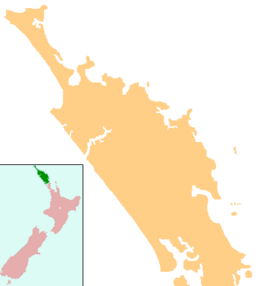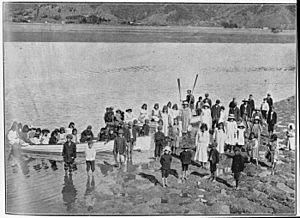Whangape Harbour facts for kids
Quick facts for kids Whangape Harbour |
|
|---|---|

Whangape Harbour
|
|
| Location | Northland, New Zealand |
| Coordinates | 35°21′0″S 173°14′0″E / 35.35000°S 173.23333°E |
| Native name | Whangapē (Māori) |
| Primary inflows | Awaroa River and Rotokakahi River |
| Primary outflows | Tasman Sea |
| Settlements | Whangape, Pawarenga |
Whangape Harbour (which is called Whangapē in Māori) is a harbour on the west coast of Northland, New Zealand. It's where the Awaroa and Rotokakahi Rivers meet. This area then flows through hills to the Tasman Sea.
The entrance to the harbour can be quite tricky for boats. There are two small towns nearby. The town of Whangape is on the northern side of the harbour. The town of Pawarenga is on the southern side. The larger town of Kaitaia is about 42 kilometres north-east.
Contents
History and Culture of Whangape Harbour
Early Māori History
Long ago, Māori people settled in the Whangape area. According to their stories, a large canoe called Māmari arrived here. Its captain was Ruānui. They came to Whangape after leaving the Hokianga area.
The people built a strong, fortified village called a pā at Pawarenga. One day, a large group of warriors from the south attacked them. The Ngāti Ruānui people were greatly outnumbered. To escape, they piled up brushwood around their pā. They set it on fire, creating lots of smoke. Hidden by the smoke, they crossed the harbour on rafts and got away.
After this event, they became known as Te Aupōuri. The name 'Aupōuri' means 'current of smoke'. This refers to their clever escape.
In 1837, a man named Edward Wakefield visited the harbour. He thought that about one thousand Māori people lived there at that time.
European Settlers and Trade
In the late 1800s and early 1900s, Whangape became a busy port. It was important for the timber trade. There was a big mill on the shore where kauri timber was processed. Many houses were built on the hills around the harbour.
Ships, first sailing ships and later steamships, would load the kauri timber. They took it to sell in other places. However, the harbour entrance was dangerous. At least four ships were wrecked there. These included the Leonidas in 1871 and the Lionel in 1877, which sadly lost everyone on board. The Geelong was lost in 1879, and the River Hunter sank in 1906.
Whangape was also a place where people dug for kauri gum. This was a valuable resin from kauri trees, used for things like varnish.
Marae: Important Meeting Places
A marae is a special meeting place for Māori people. It is a very important part of their culture.
Pawarenga has three marae:
- Mōrehu Marae, with its meeting house called Kurahaupō.
- Ōhākī Marae, with its meeting house called Te Urunga Moutonu or Maru o te Huia.
- Taiao Marae, with its meeting house called Mātaatua.
These marae are connected to a group called Te Uri o Tai, which is part of the Te Rarawa tribe.
Whangape has one marae called Te Kotahitanga. It is connected to several groups from the Ngāpuhi tribe. These include Ngāti Kura, Ngāti Tautahi, Ngāti Whakaeke, Takoto Kē, and Te Uri o Hua.
The New Zealand Government has helped to upgrade these marae. This helps to keep these important cultural places strong.
People Living in Whangape
The area around Whangape Harbour is not very big. In 2018, about 96 people lived there. This was a small decrease from earlier years.
Most people in the area are Māori (about 71.9%). There are also people of European/Pākehā background (about 40.6%). Some people identify with more than one ethnic group.
The median age of people living here was 43.6 years. This means half the people were older than 43.6 and half were younger. About 28% of the people were under 15 years old.
Education in the Area
There are schools in the Whangape Harbour area that help children learn.
Te Kura ā Iwi o Pawarenga is a school for students from Year 1 to Year 8. It opened in 2020. This school teaches mainly in the Māori language. It replaced an older school called Te Kura o Hata Maria o Pawarenga.
Whangape Native School used to operate from 1881 to 1976. It then joined with Herekino School. Other schools like Puketi and Makora Schools were open for a short time in the late 1800s. Rotokakahi Native School also operated on the harbour from 1918 to about 1969.




